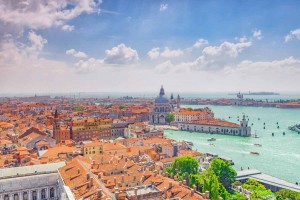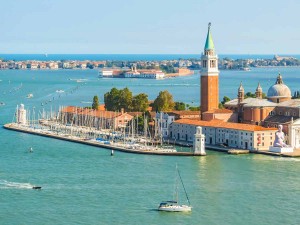
©Bigstock.com/Brian K.
Hardly any other Italian cultural landscape is as exposed to the conflict of urban development, scenic beauty, architectural intrigue and constant structural uncertainty as Venice. The legendary city with its 118 islands is situated in one of the world’s largest and most important lagoon areas. This UNESCO World Heritage Site on 50,000 km² is as attractive and endangered as few others with its 1,500 years of highly eventful history, some of the most important buildings in the world and, obviously, the conflict between multifaceted living environment and touristic influx.
A brief history of Venice
Despite assumptions that Etruscan tribes had already inhabited Venetian lagoons in pre-Christian times, the actual settlement history only started in the 5th century AD, when the Venetians were looking for refuge from barbarian invasions, which they, among other places, found on the sandy islands Jesolo, Malamocco and Torcello. Originally intended as temporary solutions, fixed settlements soon developed allowing the local population to eventually become a maritime superpower over the course of centuries; a position they had to defend against many, including Arabs, Genoese and Ottoman Turks.
Unfazed by outside influence, the lagoon settlements developed to a metropolis spread across many islands in the Middle Ages. Canals were built to further develop the urban system and to create proper water routes. Venice reached its highest number of inhabitants around 1550 with approx. 180,000 before the significance of the lagoon city started to decline. Two severe plague epidemics and a trade shift to the Atlantic caused the fall of the former metropolis. These days, Venice is mostly concerned with restoring historic buildings, flood protection and sustainable environmental policy to maintain both this unique living environment and the status of World Heritage Site.
Art and architecture

©Bigstock.com/Arndale
Starting in the Middle Ages, Venice gave important artistic and architectural impulses to all of Europe. Initially mainly influenced by the Byzantine culture, eastern influences followed in later times. Eventually, Venice and Florence laid the foundation for the Renaissance together, brought to the city by refugees from Constantinople. The lagoon city become home to important artists and established itself as an “antithesis” of sorts to the Florentine Renaissance with its architectural Gothic peculiarities and artistic highlights reaching far into the baroque.
Pretty much every building, no matter how small, is vested with glorious art; a rather massive undertaking considering the sheer mass of churches (124 to be precise), palaces and monumental buildings. You’re certainly wondering how you can see all of that in just one go. To be fair, you will probably have to stop by Venice a few more times, but that shouldn’t really be a problem now, should it? The things you can discover here are pretty awesome. Here are a few sights we particularly recommend:
- Doge’s Palace: Palazzo Ducale is one of the city’s most important Gothic buildings. Experience concentrated grandeur from the façade with its three imposing wings and the two-coloured marble to the fascinating halls and private chambers to the prison with the Bridge of Sighs.
- St Mark’s Basilica: Even more important, even more famous – the mosaics depicting the life of Jesus Christ, re-done by Titian and Tintoretto in later times, inside the over 1,000-year-old Basilica di San Marco will leave you in awe. The adjoining gallery with museum and the golden altar plate are other must-sees.
- Biblioteca Nazionale: Invaluable written works await of behind one of the city’s most magnificent façades inside the National Library of St Mark’s. 900,000 volumes and 13,000 manuscripts with a focus on Venetian history need to be viewed.
- Gallerie dell’Accademia: The Accademia, comparatively non-descript from the outside, might not necessarily be part of your travel plans. We believe that should change immediately! Find what is likely the most important collection of Venetian art spread across three buildings featuring the works of Titian, Carpaccio, Veronese, Tintoretto, the Bellinis and many other icons of the city’s illustrious history.
The lagoon as a living environment and Venice today
However, to many visitors, Venice is synonymous with the Canal Grande, the main traffic route on the water, and the numerous gondolas. 15 churches and over 200 palazzi line the route leading from the train station to the Rialto Bridge and to Piazza San Marco. The entire lagoon area around the city stretches across approx. 40 km with a direct connection to the Adriatic Sea, which supplies fresh seawater twice a day. During its original construction, mud lithified the wood used to build the city providing perfect conditions for such works. Nowadays, however, the ground causes severe problems as Venice faces the threat of subsidence – the layers of mosaic and multiple floor levels don’t help anymore.
At the same time, the lagoon, the ground, the water level and plant growth have been controlled by a special water office, which assumes a protective and cleaning function, since 1501. Joined by numerous individual protection projects, the office is busier than ever these days, as Venice has to battle severe ecological and structural consequences, which also question the city’s future status as a UNESCO World Heritage Site. Industrial impact dissolved the lithified wood speeding up subsidence. Equally, climate warming causes a drastic rise of flooding, and that’s not even mentioning the endangered biodiversity in the lagoon, or the silting in the north and depression in the south, especially caused by industrial expansion towards Mestre and Marghera.
However, not all is lost: Venice frenetically works on solutions to protect this unique living environment, to regulate the massive touristic influx and to preserve the city’s stunning art treasures for as long as possible. This alone is more than just a reason to visit the endangered, yet everything but lost UNESCO World Heritage Site. We wish you lots of fun and safe travels!